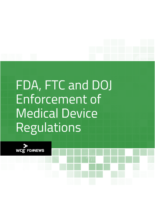
Home » 483 Roundup: FDA Hits Three Firms for Product Changes, Complaints
483 Roundup: FDA Hits Three Firms for Product Changes, Complaints
The FDA cited three device manufacturers for a range of violations including unreported product changes and failure to properly investigate complaints.
The agency issued a Form 483 to the Oakworks facility in New Freedom, Pennsylvania, following a March 2017 inspection. According to inspectors, the firm made alterations to devices without reporting the changes in writing to the FDA, and took several months to update owner manuals to reflect the changes.
The company also failed to submit timely reports on device malfunctions in at least four cases, and did not conduct quality audits often enough or document the investigations in full, the agency said. Oakworks did not investigate complaints of possible device failures in 10 cases, and lacked full documentation in six other cases.
The company also did not adequately document corrective and preventive actions, which the form noted was a repeat observation. In two other repeat observations, the agency faulted the facility’s sampling plans, which were not based on a valid statistical rationale, and said the firm did not have proper procedures for finished device acceptance.
Inspectors also hit the facility for its design verification process, which did not confirm that the design output meets design input requirements, and for lacking adequate controls for products that did not conform to specifications. The investigators also observed the firm’s device history records did not demonstrate the devices were manufactured in accordance with the device master records.
Oakworks did not respond to a request for comment.
ConMed: The FDA inspected ConMed’s Utica, New York, facility in late January and early February, and issued a Form 483 citing the devicemaker for failure to carry out timely investigations of complaints. In one case, a customer submitted a complaint in December 2015 and the firm voided the customer feedback record without evaluating or investigating it. The complaint record was not closed until September 2015, and the record claimed no device was returned even though the inspection found it was returned on March 18 of that year.
The Form 483 also faulted ConMed for its medical device records, noting that a complaint record opened in August 2015 listed inaccurate information for the device’s brand name and catalog number.
ConMed did not respond to a request for comment.
Ultrasonic Services: The agency also issued a Form 483 to Ultrasonic Services after a March inspection of its Houston, Texas, facility. The company implemented a design change for one of its devices without supplying adequate supporting documents, the agency found. The design change allowed Ultrasonic’s devices to be manufactured with either dual or single frequencies, while the device was only approved for single frequency.
The firm also lacked an established design history file and documentation to prove its device design was developed according to regulations. On at least two occasions, Ultrasonic redesigned device components without documentation to support the changes.
Ultrasonic declined to comment on the Form 483.
Medical Alignment Systems: The FDA cited Medical Alignment Systems, citing problems with their data reporting, written procedures and handling of complaints.
Following a March inspection of the device maker’s Centerville, Utah, facility, the FDA issued a Form 483. According to the FDA, the facility did not submit required annual reports for some of its products, with the company submitting no annual reports for its SSL laser devices in the past four years. MAS also failed to develop written procedures for reporting, including for incidents of accidental radiation, according to the form.
The firm also lacked no procedures for handling complaints or corrective and preventive actions.
The agency also faulted the facility for lacking established procedures for handling nonconforming materials. According to inspectors, the firm also did not thoroughly investigate potential suppliers’ qualifications or their ability to meet requirements and had no established procedures for purchasing controls. Lastly, officials found the firm did not document its inspections of incoming material or record whether it accepted or rejected incoming products.
Brandt Equipment: The FDA issued a Form 483 to Brandt Equipment of Bronx, New York following a Feb. 6-13 inspection, citing the facility for failing to properly maintain complaint files. Some complaints received by the firm lacked complete information and were not signed by the approving official, the agency found.
The agency also cited Brandt for inadequate procedures for acceptance of incoming product.
If your company hasn’t received a 483 with CAPA observations, you can match your systems with those that have and ensure that all gaps are closed before your next inspection. Remember, you have only 15 days to respond to a 483. Most of that time will go toward bringing your CAPA program into compliance. Don't waste a second trying to figure out how to communicate those plans in a way that will convince the FDA you are focused on improvement and committed to quality. Learn from those who have been there. Order Effective 483 Responses: Focus on CAPA Violations today.
Upcoming Events
-
23Apr
-
25Apr
-
07May
-
14May
-
30May

